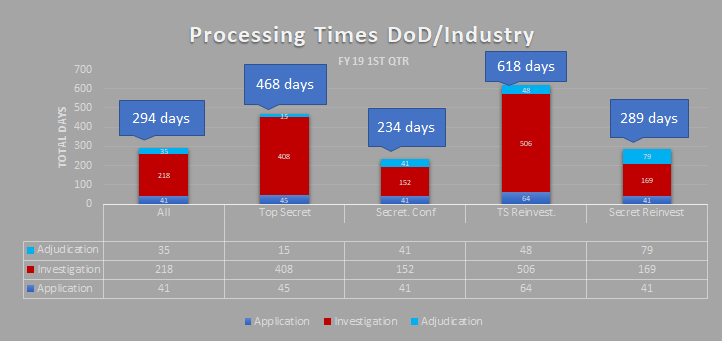While the National Background Investigations Bureau (NBIB) has made significant progress reducing the size of the backlog of pending security clearance investigations – reducing the backlog by nearly 25% in the past year – progress on increasing security clearance processing times has largely stalled, according to recently released DoD/Industry security clearance figures.
Processing times for DoD/Industry applicants have bumped up again slightly – with average Top Secret clearance processing times at 468 days, and Secret clearance processing times at 234 days. The lack of forward progress on processing times is not unexpected – in a media briefing on the status of the Trusted Workforce 2.0 initiative, ODNI officials highlighted that the efforts in the first year of the personnel security program overhaul had largely been focused on improving the steady state of the security clearance backlog of cases – from a high of 725,000 cases to roughly 541,000 cases – a 25% reduction.

What will it take to improve processing times?
Security clearance processing times for DoD/industry applicants are at a slight improvement from the highs seen in the second quarter of 2018 – when a Top Secret security clearance took a whopping 543 days to process, and a Secret security clearance took an average of 325 days to process – all for the fastest 90% of applications (not the troublesome last 10%). But despite more than a year of congressional hearings, passage of the Secret Act, and the construction of an executive order to transfer the background investigations mission to NBIB – why haven’t we seen processing times improve?
The lack of progress may actually be a byproduct of current efforts to increase cyber vetting and transfer background investigations authority to the DoD. The 2018 National Defense Authorization Act (NDAA) mandated DoD take over its own background investigations, a job previously done via appropriated funds through the Office of Personnel Management’s NBIB. The 3-year phased approach means DoD gets to slowly take over control of its own investigations – and guess which ones it’s fielding first? The low-hanging fruit of easy to process Secret clearances, or T3R investigations. While the details of the phased approach have not been made public, the NBIB has shown an increase in the number of high-intensity field work Secret clearance investigations for DoD applicants. Why the major shift in the number of complex DoD cases? Just a sketchier batch of defense contracting applicants to ring in the New Year? Not likely.
The greater likelihood is that DoD is now able to begin onboarding at least some of those initial Secret clearance investigations internally – putting the candidates through cyber vetting, and only punting the more complex cases to NBIB. What NBIB is left with is a proportionally higher number of Secret clearance investigations and reinvestigations requiring more complex field work – the kind of field work that is still time-consuming and drives processing times higher.
Keep in mind that without knowing how many new clearances DoD is phasing into Continuous Evaluation, or what the current status is of the executive order to transfer security clearance responsibility, this is somewhat speculative. But the influx in more complex caseload for NBIB at phase 1 of DoD’s new background investigations authority correlates with a hypothesis we’ve been predicting for awhile – as NBIB and DSS continue to run concurrent personnel security programs, we can expect reported processing times to get worse, before they get better.
This doesn’t mean overall processing times are slower – security officers have noted anecdotal improvement in processing times for some background investigations, and uncomplicated Secret clearance investigations, in particular. As recently as fall of 2018 some offices were seeing Secret clearance investigations processed in as little as three months – for non complex cases. The bad news is if you’re an applicant with a complicated case, your processing times may be worse.
Trusted Workforce 2.0 Promises Better Processing Times Ahead
ODNI officials note “common sense” adjustments have already been put in place to help improve security clearance processing times – things like allowing video teleconferencing for interviews with individuals located overseas, and NBIB’s efforts at hubbing in order to bust through a large number of pending investigations in one location. But the big picture changes needed to get security clearance processing times close to the goal mark are likely to come this year.
Of the six points in a newly released ODNI and OPM security framework, expanding the investigative methods available and implementing a trusted provider program are both on the table. ODNI is also considering big picture overhauls to the things like the number of adjudicative criteria and defining who is trusted in the ‘whole person’ concept.
So, are security clearance processing times truly worse across the board? Or is NBIB just fielding more complex investigations? Unfortunately, security clearance processing times which appear worse are likely a symptom of the transition pains as NBIB and DSS continue to work toward a merger – and a finalized executive order.




